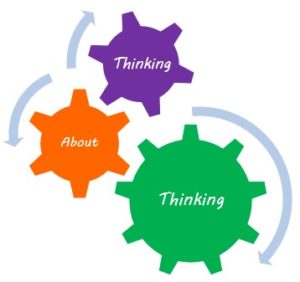Metacognition
 Metacognition is literally thinking about thinking. This basically means that as a teacher you not only need to teach about subjects and topics that need to be learned but to also teach how to learn. There are many different learning strategies that students can learn and apply. Listed below are strategies that I apply in my own classroom.
Metacognition is literally thinking about thinking. This basically means that as a teacher you not only need to teach about subjects and topics that need to be learned but to also teach how to learn. There are many different learning strategies that students can learn and apply. Listed below are strategies that I apply in my own classroom.
One from Michael Graves recommends teaching students what to do when they encounter an unfamiliar word. Not only do they need to recognize that the word is unfamiliar, they also need to determine how important it is to know the definition. Here is his recommended procedure:
-
- Students reread the sentence containing the word.
- Students use context clues to figure out the meaning of the word, and if that doesn’t work, they continue to the next step.
- Students examine the word parts, looking for familiar root words and affixes to aid in figuring out the meaning. If they’re still not successful, they continue to the next step.
- Students pronounce the word to see if they recognize it when they say it. If they still can’t figure it out, they continue to the next step.
- Students check the word in a dictionary or ask the teacher for help.
This procedure has a great chance of success because it incorporates three different word-learning strategies.
Here are some examples of common test-taking strategies. Students who are taught these strategies become “test wise” and are more likely to achieve.
- If the words “some” or “often” or similar vague words are used in one of the options, it is likely to be the correct option.
- The option that is longest or most precisely stated is likely to be the correct one.
- Any choice that has grammatical or spelling errors is not likely to be the correct one.
- Choices that do not attach smoothly to the stem of the question are not likely to be correct.
- Read test directions carefully.
- Find out how questions will be scored. Will all questions count equally? Will points be taken off for deficiencies in spelling, grammar, or neatness?
- Pace yourself to ensure that you can complete the test.
- Plan and organize essay questions before writing.
- Attempt to answer all questions. Guessing is not penalized, so guess when you don’t know the answer.
- When using a separate answer sheet, check often to make certain that you are marking your responses in the correct space.
- Be in good physical and mental condition at the time of testing by avoiding late-night cram sessions.
These are some final ideas to help students succeed on standardized tests. First, be sure to include formats that are likely to show up on a standardized test in your own assessments. By using these formats, students become familiar with the procedures and expectations. A second idea would be to analyze answers from previous tests. Some answers are designed to trick a student, but if he or she can identify why it might be there, then they are more likely to identify the correct choice.